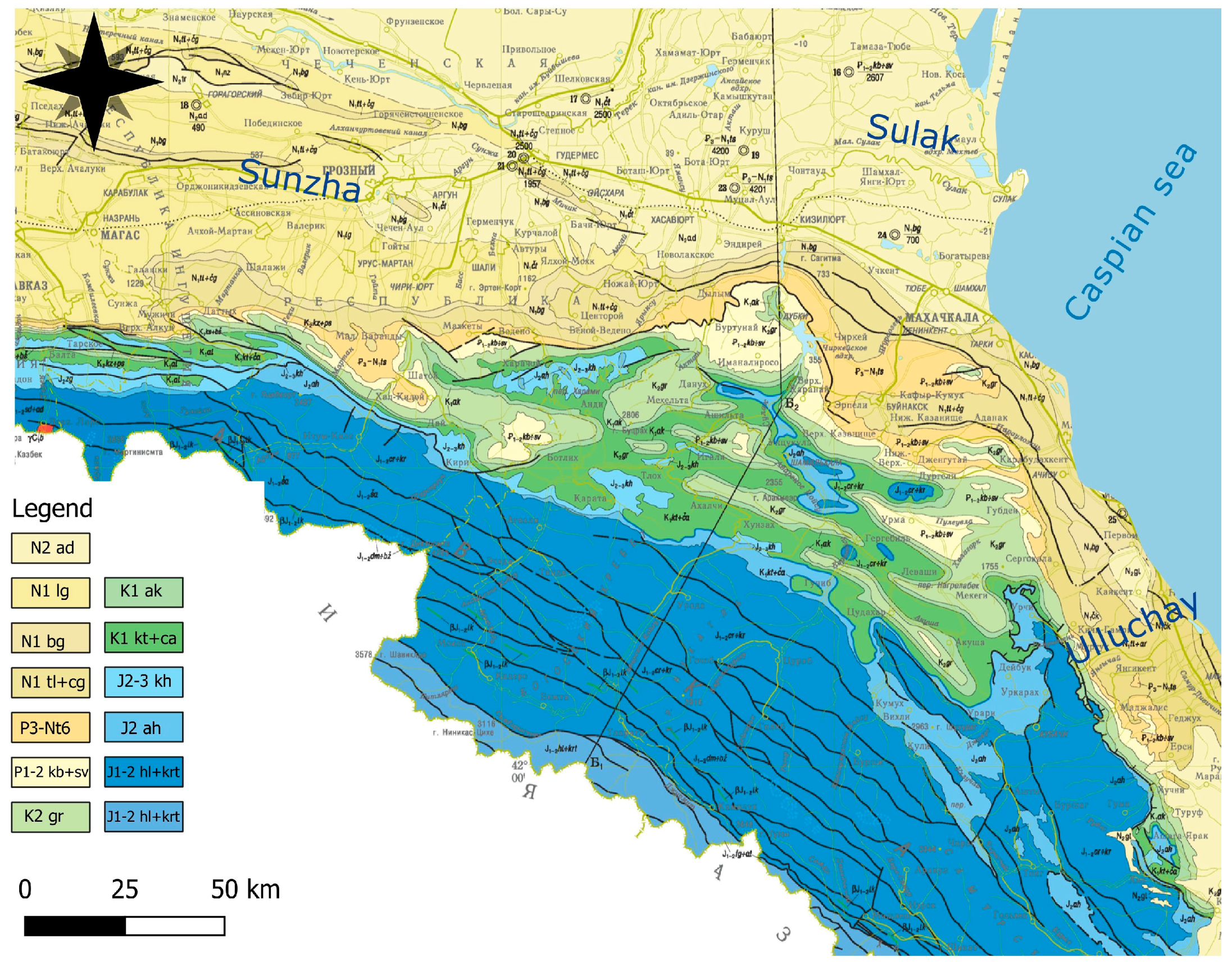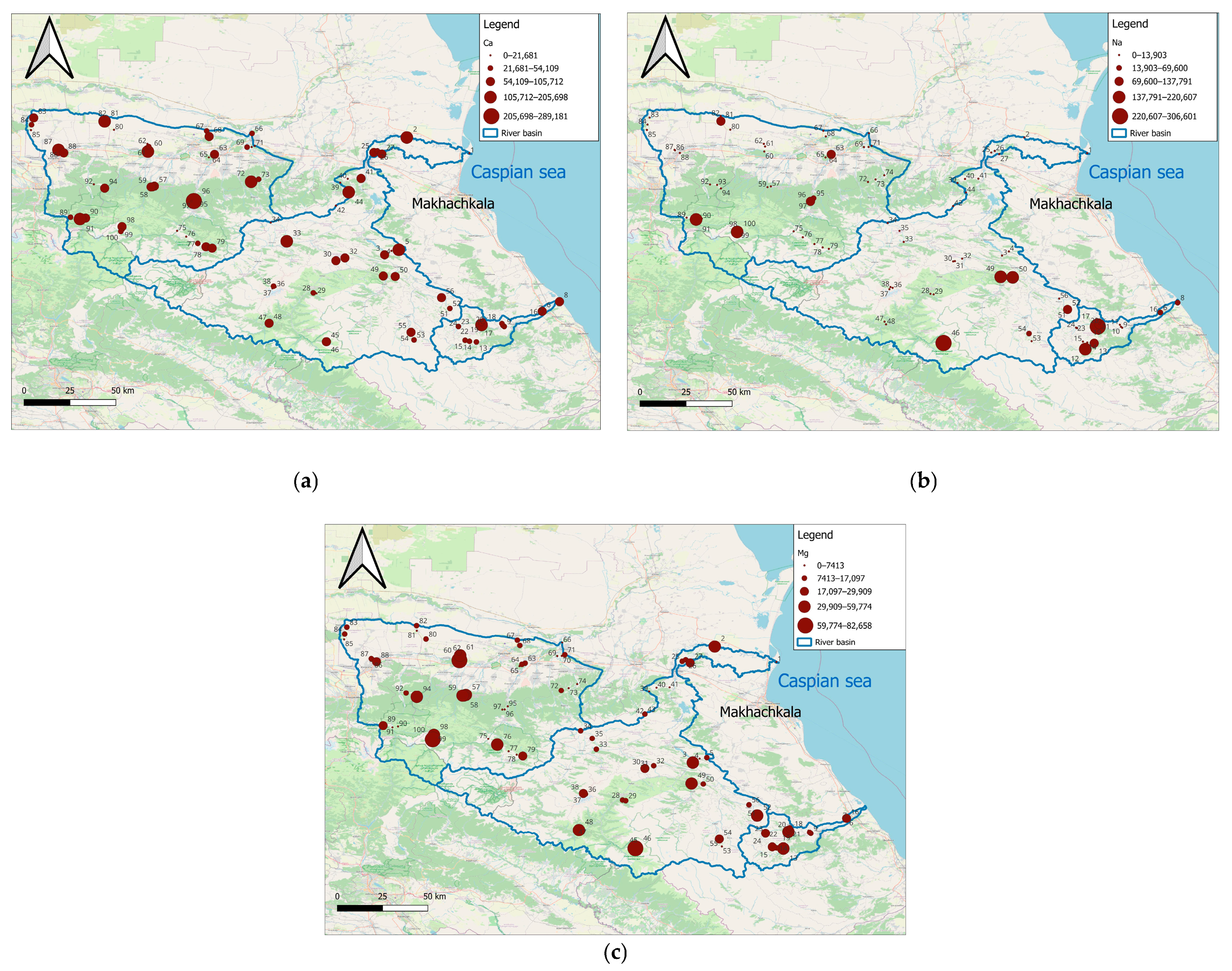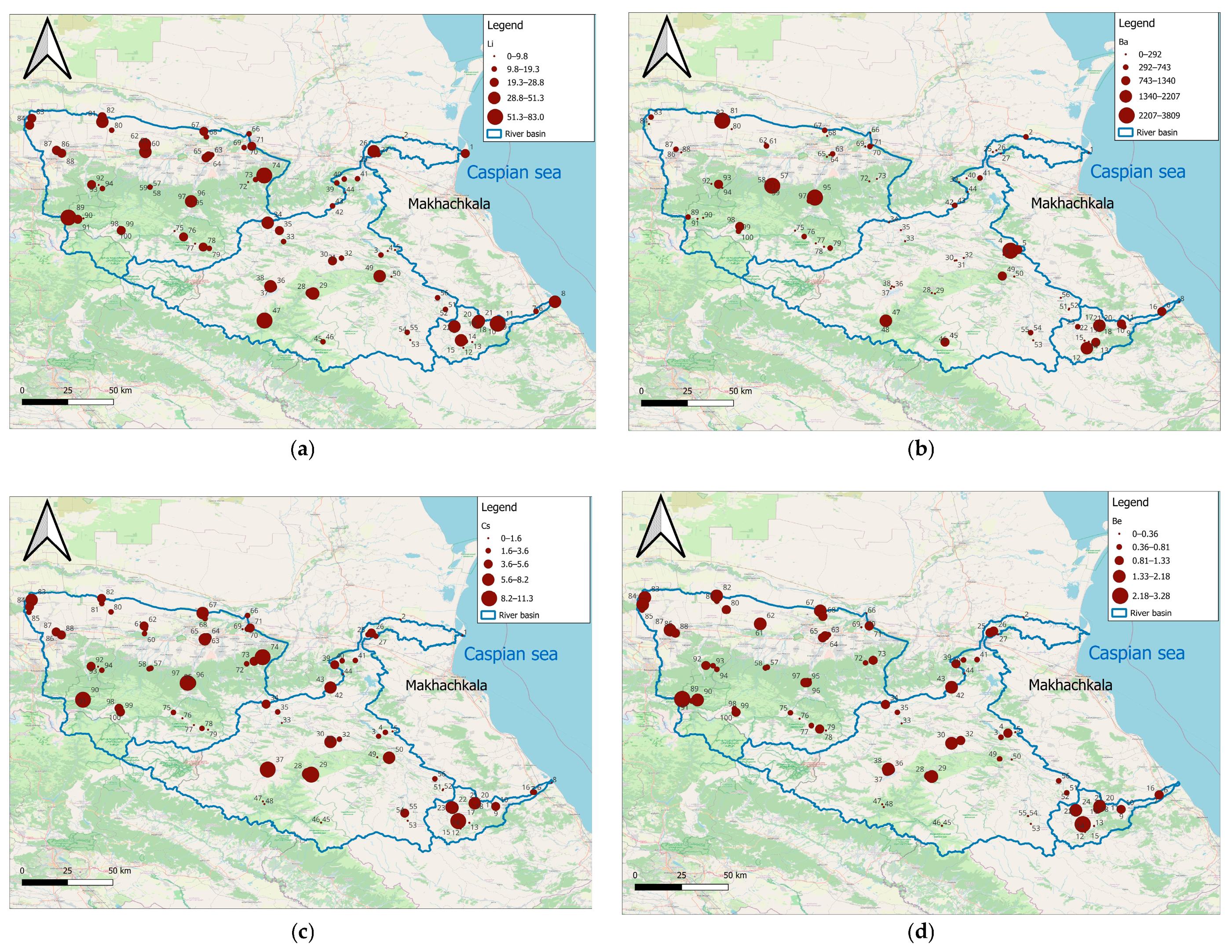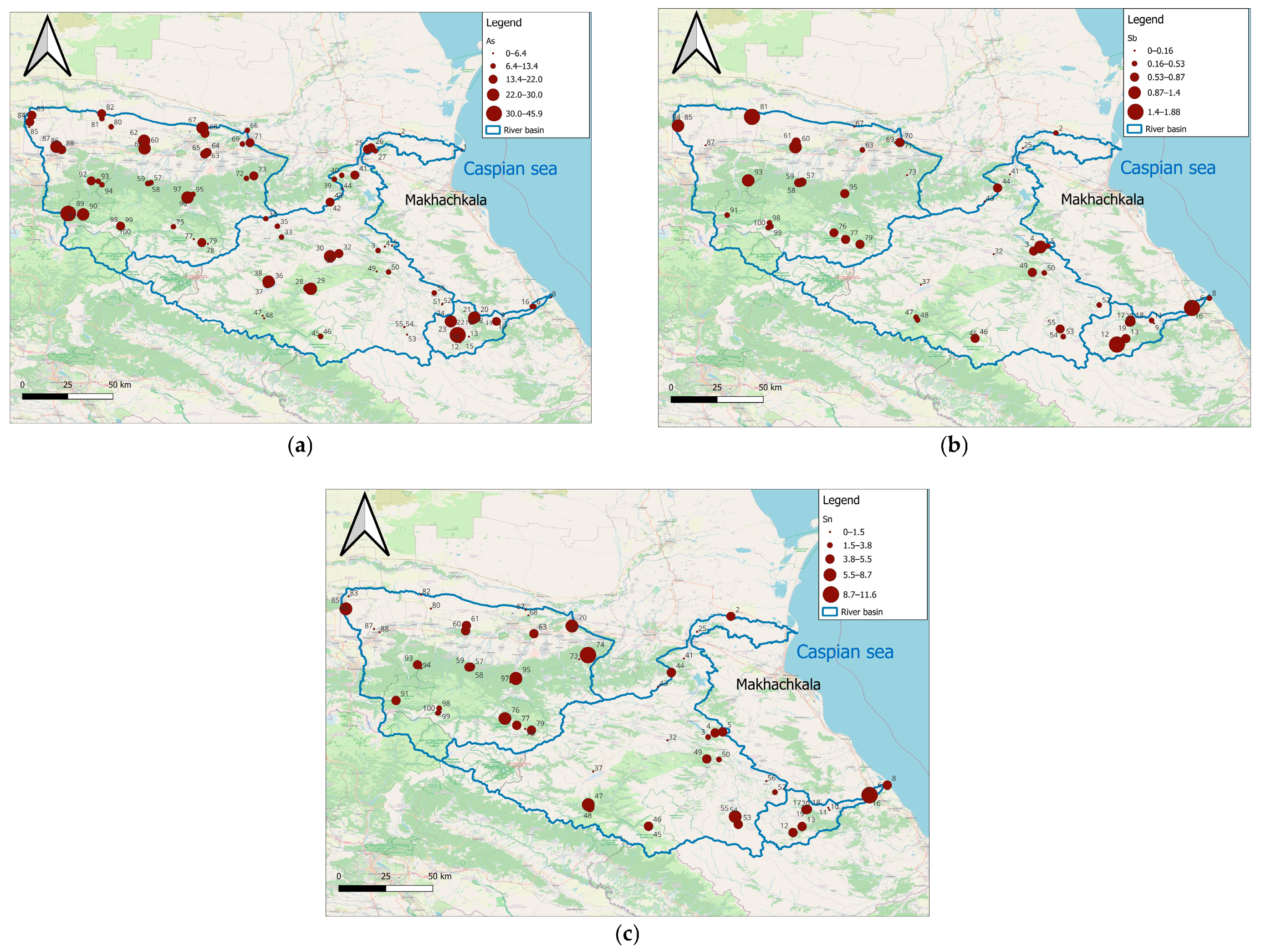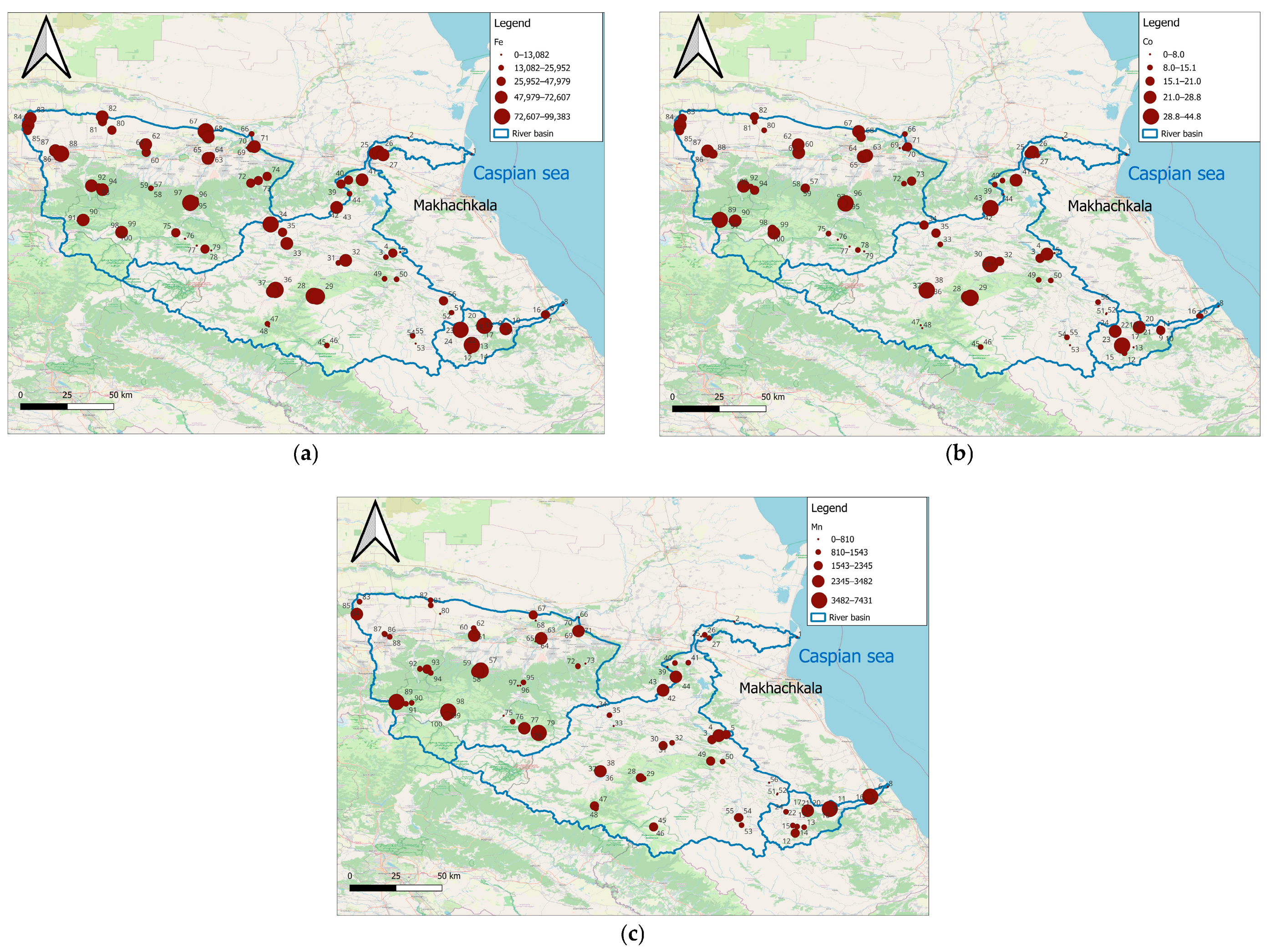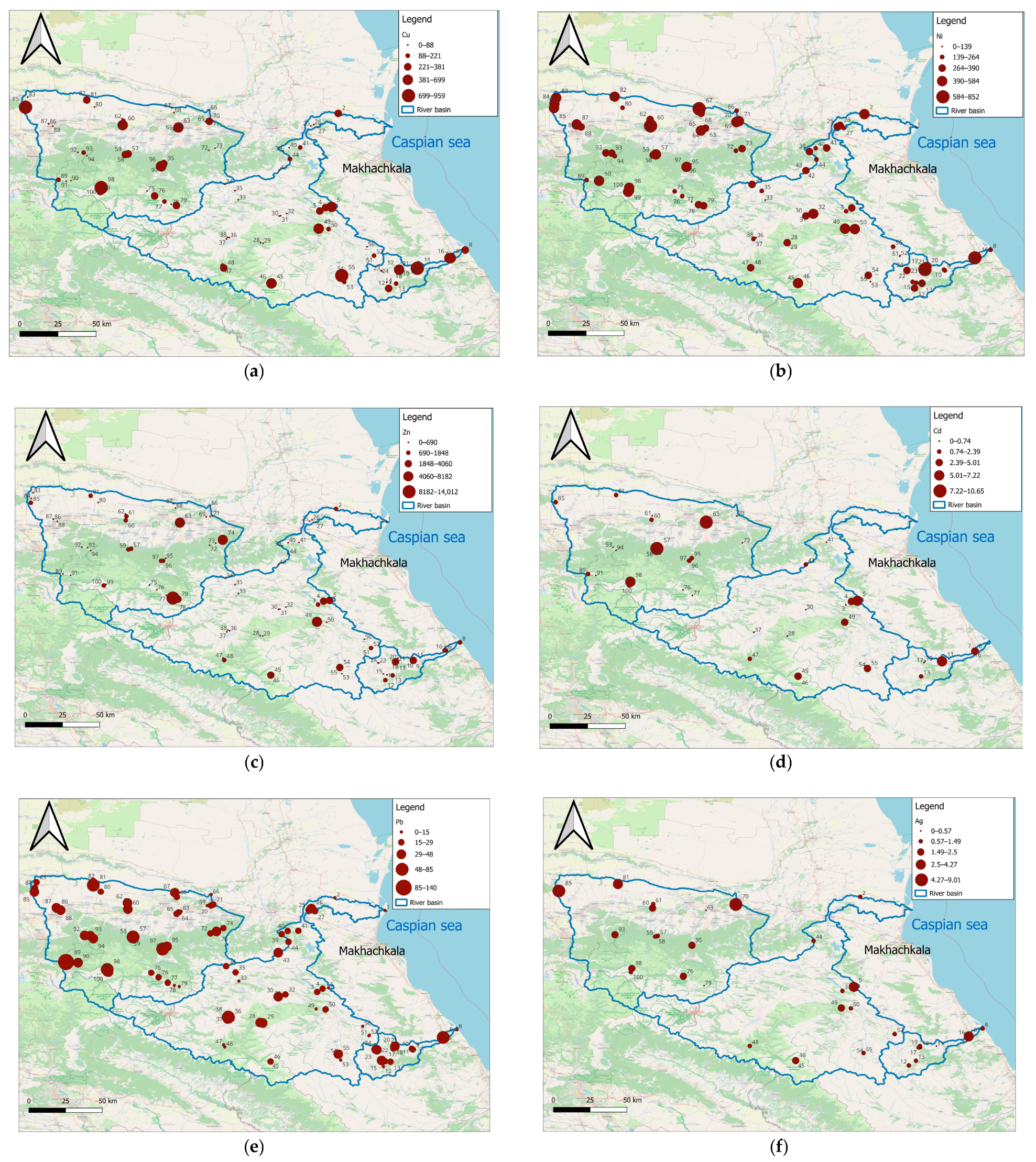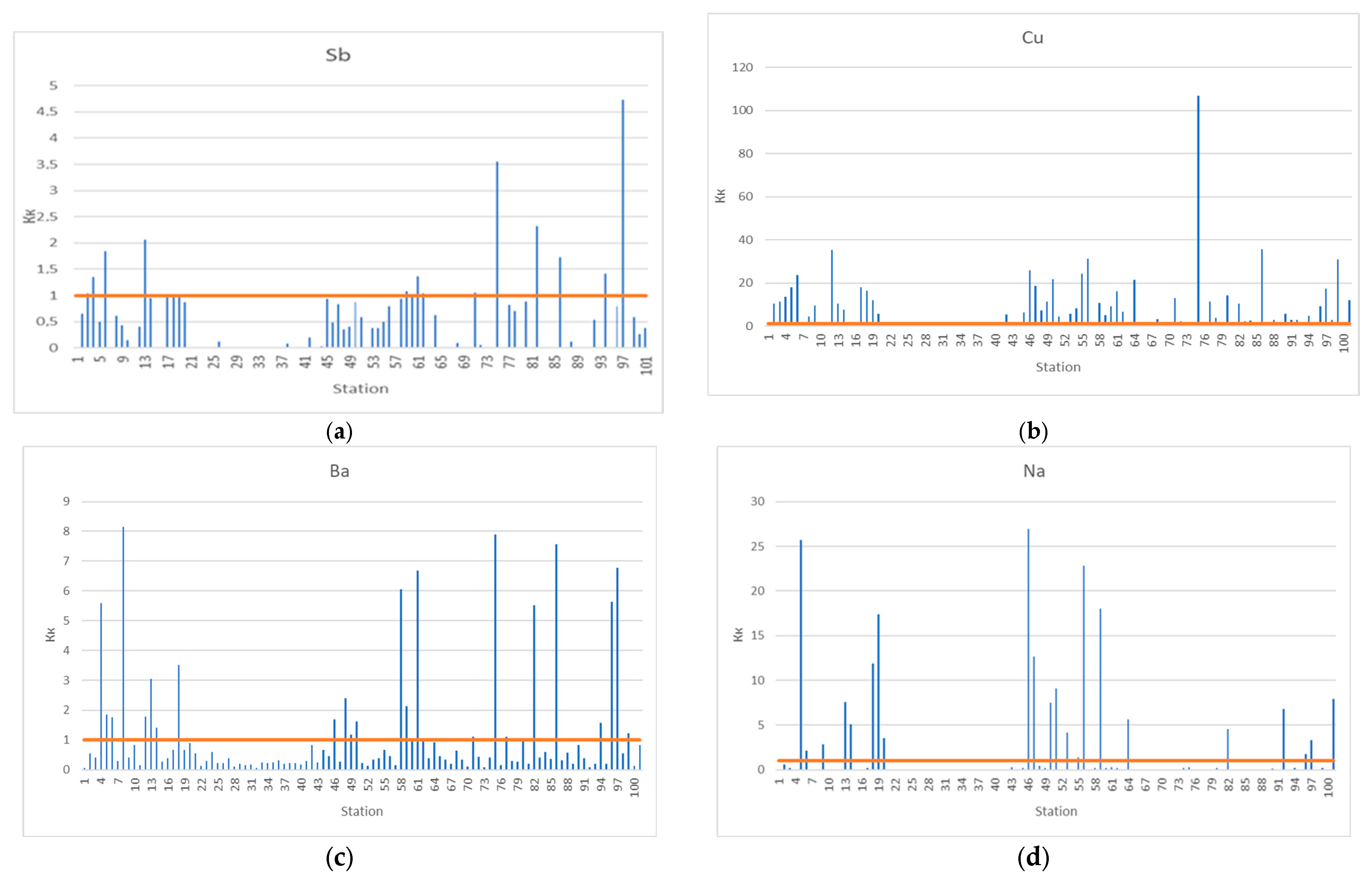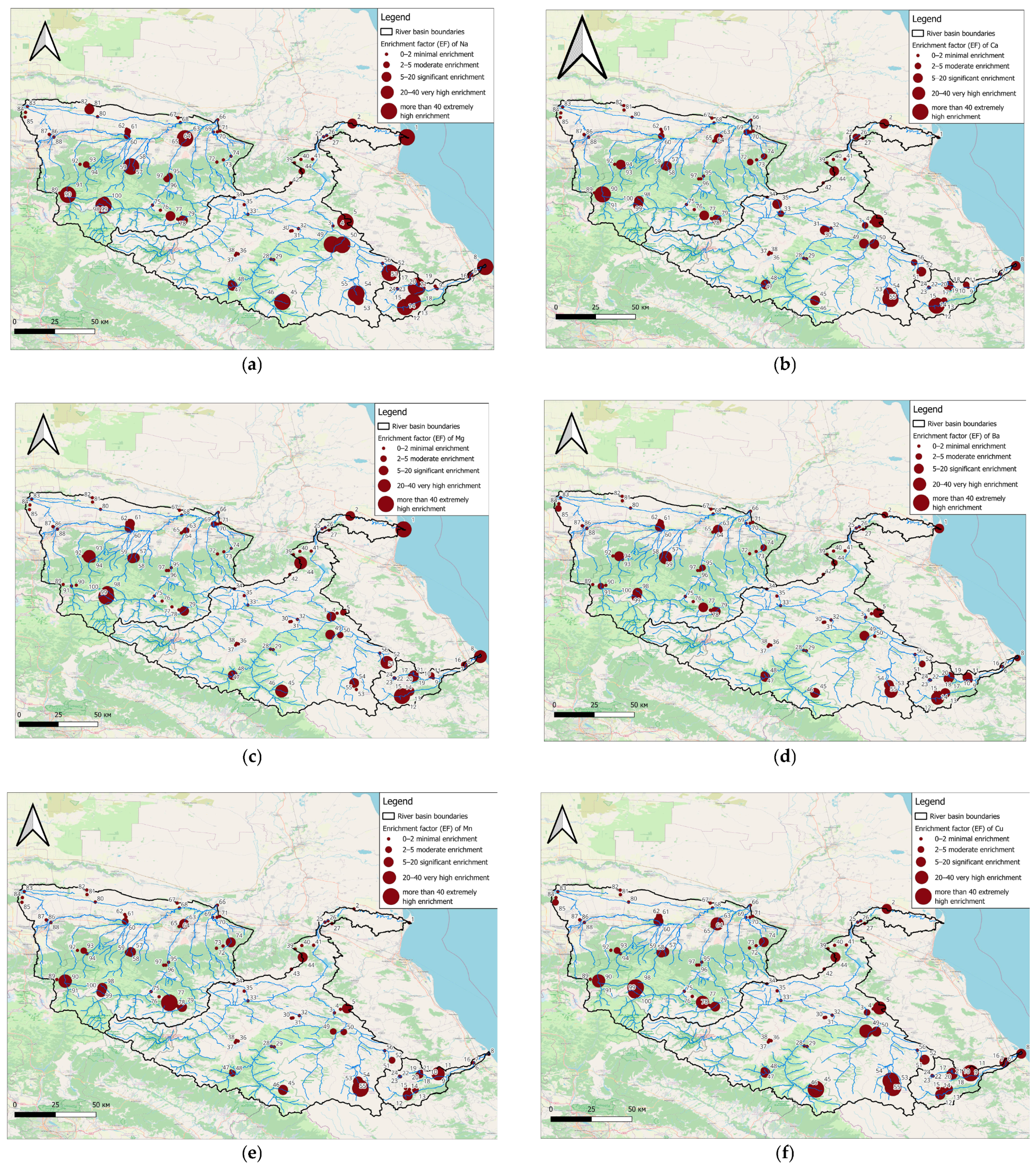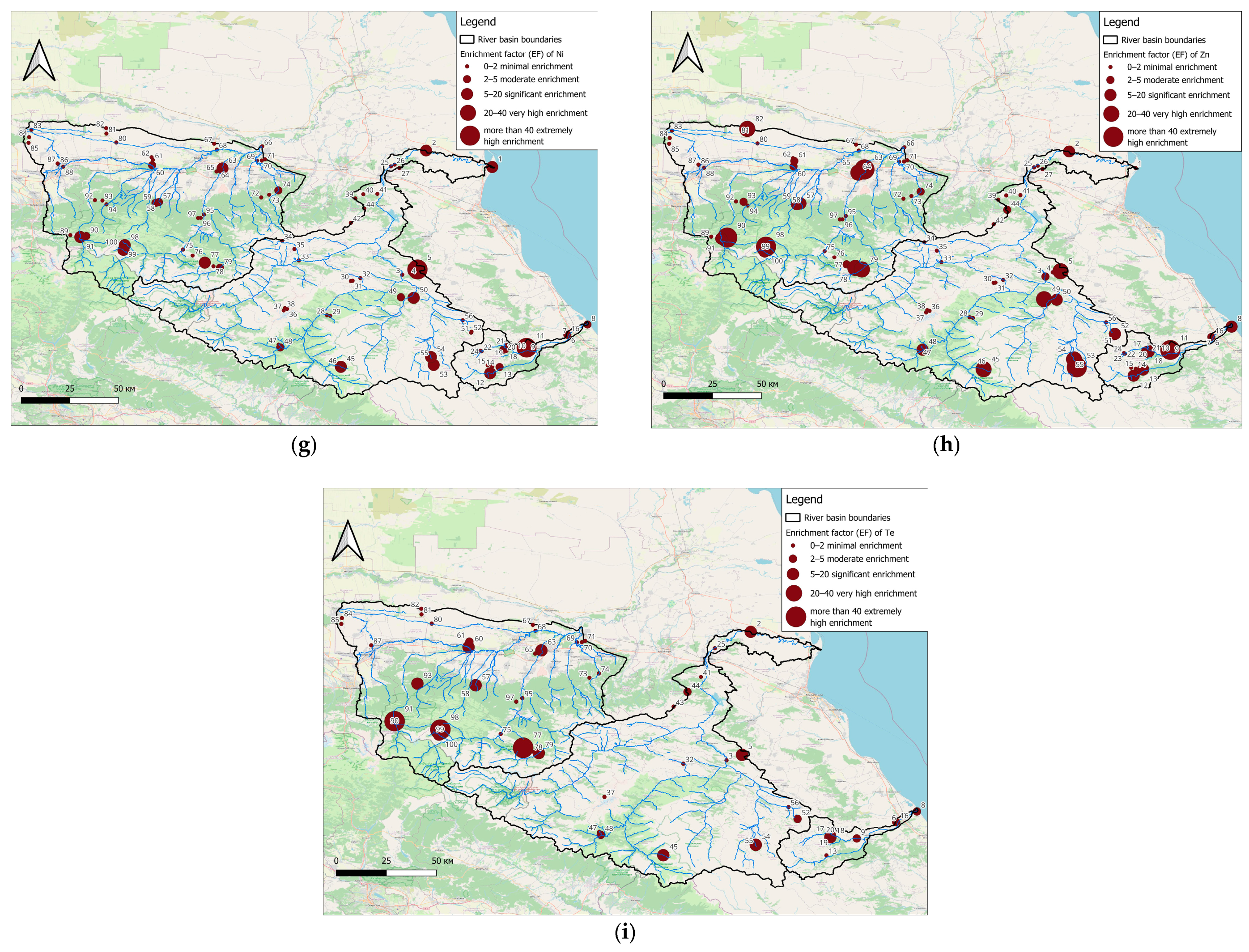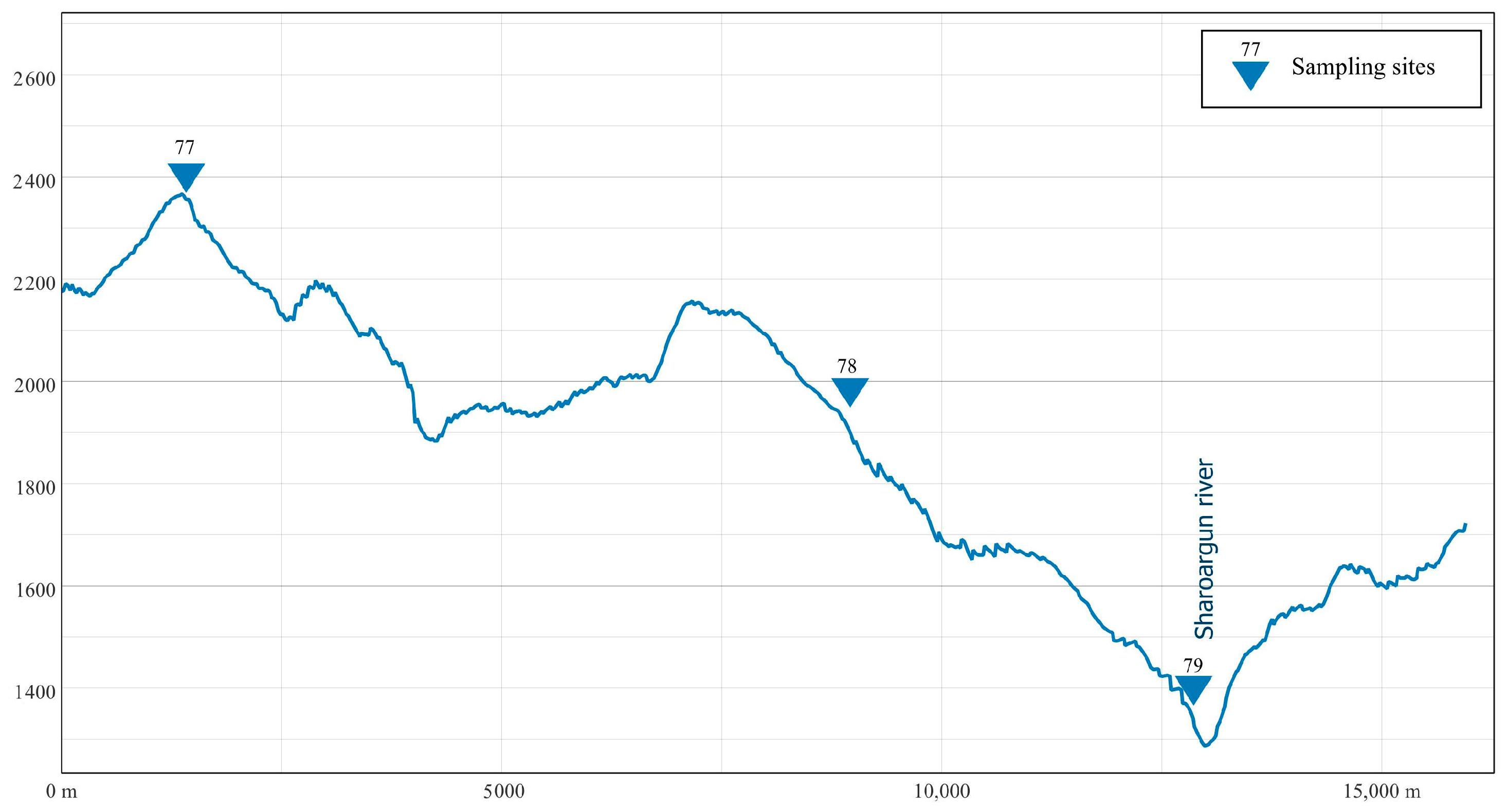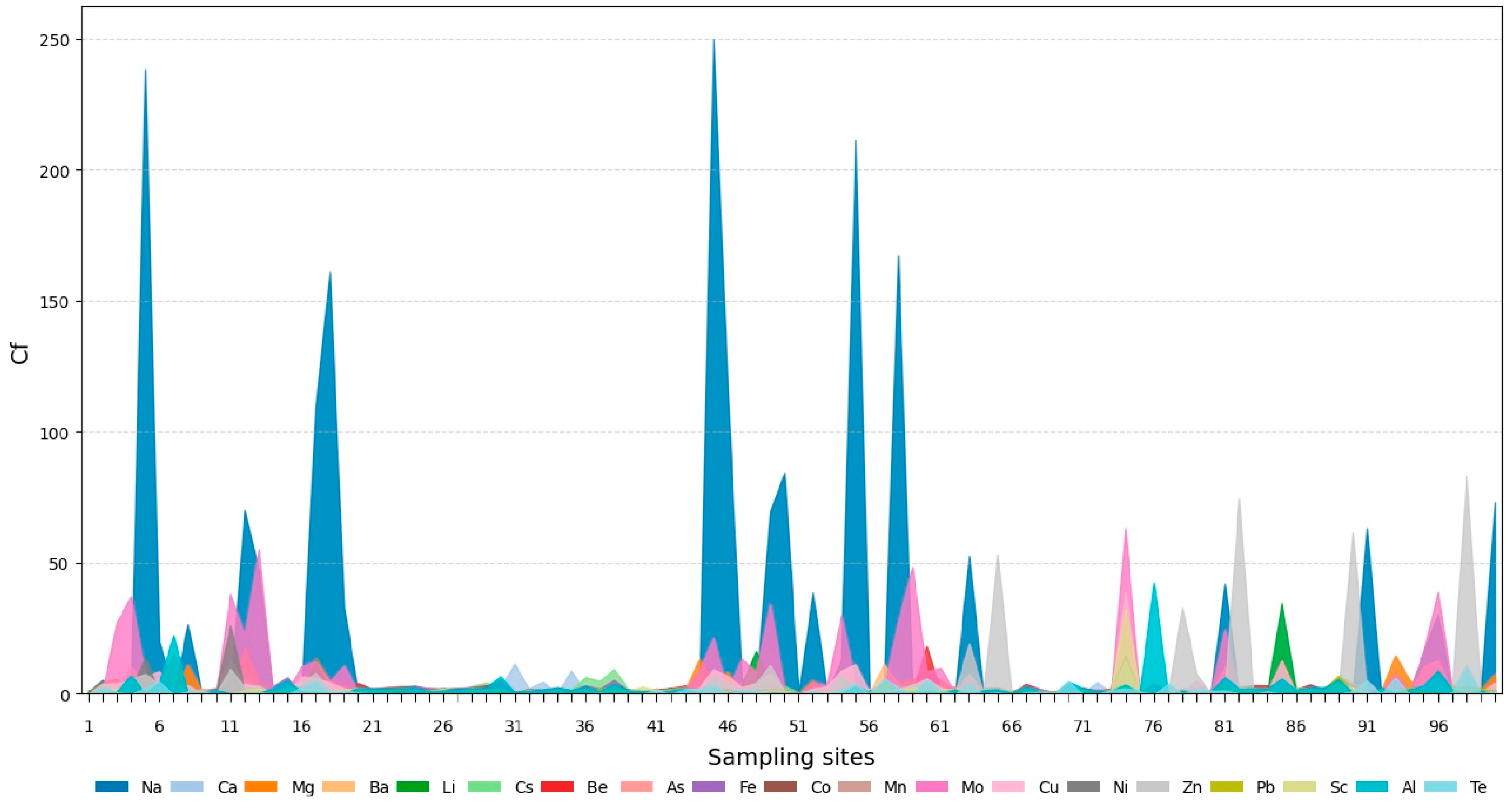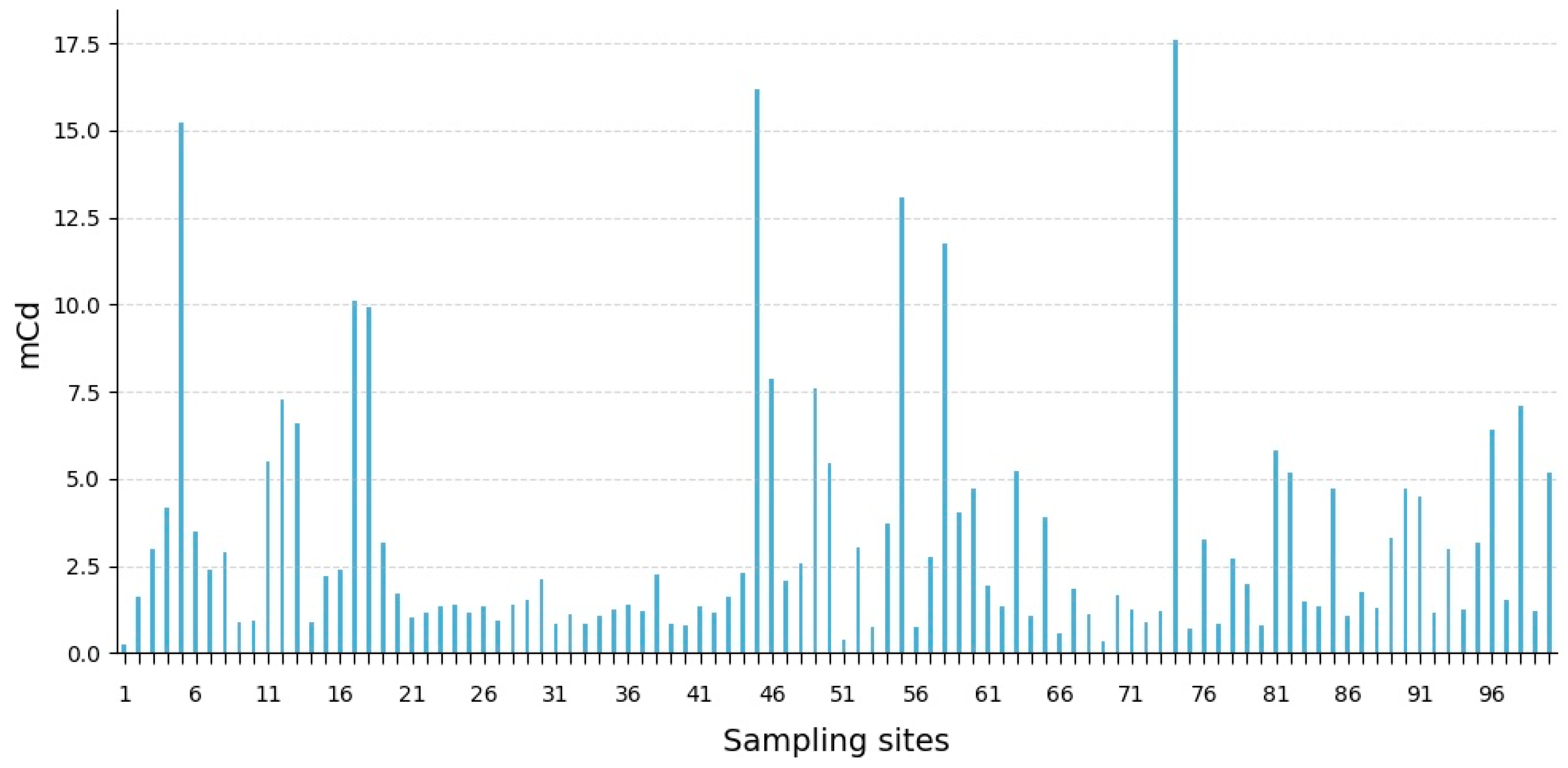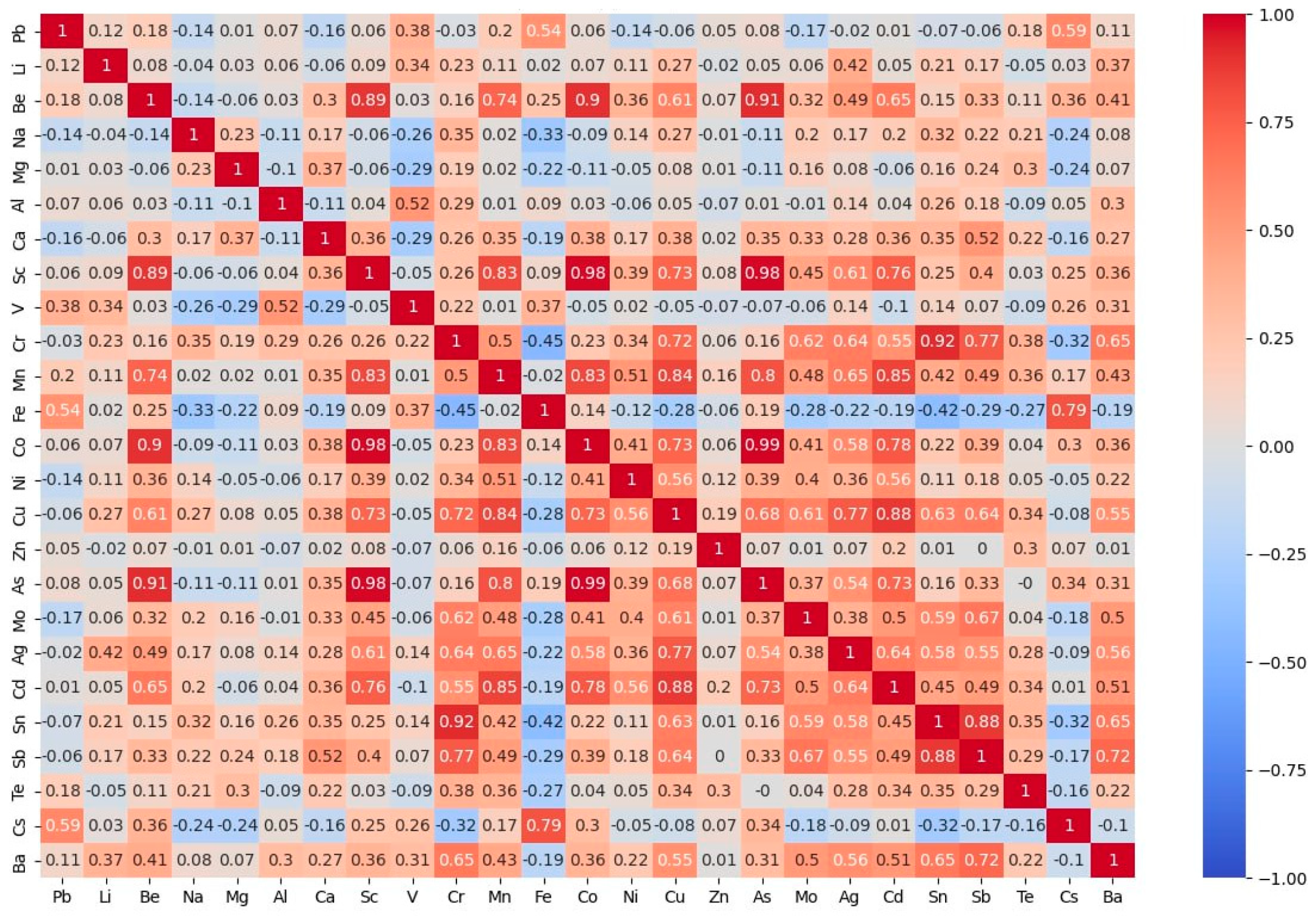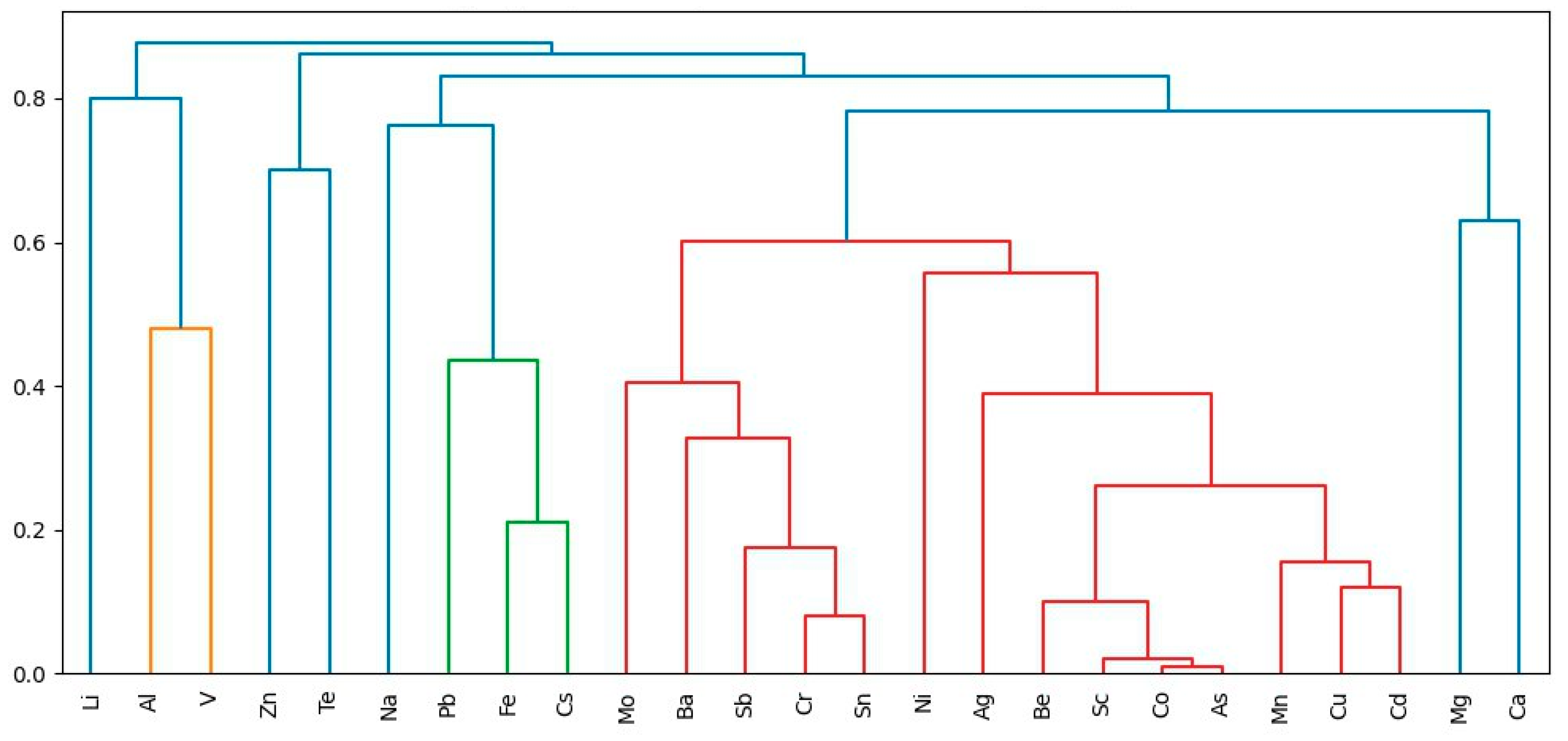4.1. Analysis of Element Contents and Their Anomalies
There is a very high variation in the chemical element content in the upper soil horizons of the river basins of the Northeastern Caucasus.
Na, Ca, and Mg belong to mobile cationic elements, lithophilic water migrants with constant valence.
Na and Mg are salt-forming elements, the distribution of which is influenced by climatic factors and hydrogeochemical processes [
79]. The elements are accumulated in water in the arid conditions of the Dagestan plain as a result of evaporative concentration and the accumulation of salt and gypsum.
Mg and Na contents relative to Clarke values and regional background show similar trends: increased concentrations in the lower parts of the Ulluchay and Sulak rivers, the middle reaches of the Sulak River between Kizilyurt and Urus-Martan, and the highlands of the Sunzha River Basin. In the upper reaches of the Ulluchay River and the northeastern part of the Sulak River, concentrations of Na and Mg relative to the Clarke and regional background decrease sharply. In the coastal strip of the Caspian Sea, the increased content of Na and Mg is caused by the influence of sea salt. The salinization of soils formed on terrigenous–carbonate deposits of the Dagestan plain increases when moving from upper hypsometric levels to lower ones along the landscape–geochemical catena with increasing salinization [
48,
80]. This trend is consistent with studies of geochemical patterns in the soil profile above mineralized bedrock, where it is shown that Na and Mg concentrations decrease with increasing distance from the source, reflecting the migration of elements through the soil [
81,
82]. At high values of the enrichment factor (EF), their content is within the regional background, which is also confirmed by low values of the contamination factor (Cf).
In the anomalous zone, Na concentrations in the topsoil horizon are an order of magnitude higher than in the underlying soil horizons: 306,600.70 mg/kg (Ad 0–5 cm), 38,919.15 mg/kg (AC 5–17 cm), and 6423.01 mg/kg (C 17–42 cm). This distribution may reflect local anthropogenic contamination. Approximately 100 m upslope are currently cultivated areas, including pastures and abandoned agricultural terraces. The elevated Na concentrations may be linked to the prolonged application of fertilizers, such as sodium nitrate.
Ca is present in landscapes with a living substance in elevated concentrations in waters with a calcium composition. It accumulates in arid landscapes, and it is rich in the soils of steppes and deserts. In most of the studied territory, the Ca content is higher than its Clarke value in the lithosphere and higher than the regional background. High concentrations of Ca are due to the historical formation of the area—an accumulation of sediment of marine origin with a high content of calcium carbonate.
The weak cationic elements of lithophilic water migrants are Ba, Li, Cs, and Be.
Ba is unevenly distributed across the territory, with accumulation zones in the south-eastern part of the Sulak River Basin and the upper part of the Ulluchay River Basin, and dispersion in the middle reaches of the Sulak River. For the area of the Sunzha River Basin, the general distribution patterns of Ba are not noted. However, Ba forms four regions with abnormal concentration. All Ba anomalies are confined to mountainous areas: the slopes of the Lesisty, Sunzhensky, and Gimrinsky Ridges. On the slope of the Gimrinsky Ridge, Ba accumulates in alluvial meadow carbonate light loamy soils, whose profiles are enriched in this element. The soil-forming material is weathered calcareous deluvium. In the Sunzha River Basin, all Ba anomalies were recorded in soils developed on carbonate bedrock (limestones).
Anomalies of Ba are associated with alkaline conditions and pH values above 7.5. Ba activity is higher in humid landscapes with hydrocarbonate waters compared to arid conditions with sulphate waters. It accumulates with living matter and settles on sorption and sulphate barriers. Ba precipitates on carbonates under acidic and mildly acidic water conditions. High Ba concentrations coincide with gypsum–carbonate horizons, which serve as geochemical barriers for barium [
83]. Elevated Ba content is associated with soil salinity in trans-accumulative positions and the sulfate content of soil solutions, promoting its precipitation as barite [
48].
The sources of Li in the landscape can be very diverse. For example, research in Guizhou Province has revealed significant lithium enrichment in the clay rocks of the Lianshan Formation. Li
2O content reached 0.3%, which is related to the weathering of the limestone in warm and humid climates, as well as to the accumulation of kaolinite (up to 93%) in deposits. Additional study in the region confirmed that lithium enrichment is associated with the dolomites of the Lowhangguan Formation and that lithium is associated with clay minerals [
66]. In the Mufushan (South China) area, Li anomalies are associated with the granite inductions of the Mufushan complex [
84,
85]. In the salt plain of Olaro (Central Andes, Argentina), Li concentrates due to the evaporation of brine, and sources of lithium are the weathering of volcanic rocks and hydrothermal activity [
86,
87]. The diversity of lithology and complexity of the history of geological development of the territory determine the possibility of finding Li in the basins of rivers of the Northeast Caucasus of different origin: in argillaceous rocks of the foothills, in deposits of the highlands, and in the evaporation of salt deposits on the plains. Li forms one anomaly, which is represented in the Sunzha River Basin.
Cs content does not have a general trend—areas with Clarke exceedance and significant reduction of concentration compared to the average content in the lithosphere are identified. Cs refers to scattered elements of the lithosphere. Anomalies of Cs content have not been detected, but an area of elevated concentrations (up to 4.5 from the Clarke, 21.8 mg/kg) has been identified in the basins of the tributaries of the Sulak River—the Avar Koisu and the Andi Koisu. Sorption and accumulation of Cs may be related to the dispersal of clay minerals across the territory. The soil-forming rocks of Dagestan limestone are enriched in Cs. The limited influence of biogenic processes on the formation of loose deposits increases the role of mechanical weathering of rocks and their subsequent migration [
48]. The Cs scattering zone is located in the lower Sulak and Ulluchay Rivers.
Be is scattered relative to the Clarke in the studied territory, but it exceeds the regional background content several times over. The element is widely found in soil, but at a low level [
88,
89]. A study of the behavior of Be under different environmental conditions showed that sorption and desorption of Be depend on pH, temperature, and the presence of competing ions [
90]. Very high Be anomalies are due to geogenic sources and volcanic activity, shown by example in the Campania region (Italy), where Be concentrations reach 80 mg/kg [
88,
91]. In the study area, sampling sites with Be concentrations of up to 18.76 mg/kg were observed, which does not represent an exceptionally high concentration. It should be noted that the high Be contamination coincides with the Ba anomalies. Solubility and mobility of Be are increased in an alkaline medium at a higher pH due to the formation of soluble complexes with hydroxide ions [
92]. Be refers to the elements of soda migration. From aqueous solutions, the element is precipitated by the sorption of clays and iron hydroxides.
As, Sb, and Sn are characterized as weak-moving anionic elements, lithophilic water migrants.
The content of As in soils is often higher than the Clarke and higher than the regional background, which is related to its ability to be absorbed by silts, clays, and organic matter. However, As concentrations in the soils of the Northeastern Caucasus are lower than the global average, which is 19.1 mg/kg [
93]. The element often settles on carbonate geochemical barriers. There is a slightly reduced (to Cf = 0.5) content of As in the coastal zone in the basin of the inflow of the Sulak River—the river Kara-Koisu. Geologically, the zone is composed of dense Upper and Middle Jurassic igneous rocks. Anthropogenic sources of As include agriculture and forestry, where arsenic compounds are applied as pesticides.
Sb and Sn are distinguished by their very low presence, often below the sensitivity level of chemical–analytical equipment.
The low content of Sn is due to the predominance of sediments, mainly limestone, rock, and depleted tin. The Sn content increases with an increase in the influence of rock-forming elements under the conditions of a decrease in the role of biogeochemical processes and a decrease in the capacity of the biogeochemical cycle. Such areas include areas that are practically devoid of vegetation cover—scree, cliffs, and semi-deserts [
48].
Sb refers to scattered elements of the lithosphere, the concentration ratio of which also rarely exceeds a Clarke in the basins of the rivers of the Northeastern Caucasus. The content of Sb increases in the Sunzha River Basin at individual points between 3.5 and 4.5 from the Clarke. The oblique lakes are found in the lower basins of the Sulak and the Ulluchay Rivers and in the eastern part of the Sulak Basin (the Kara-Koisu River).
Fe, Co, and Mn are halophilic and siderophilic cationogenic water migrants whose mobility is related to the aquatic environment.
Fe has a high Clarke in the lithosphere, and its content in the upper soil horizons of the Northeastern Caucasus is close to the Clarke. The mobility of Fe is closely related to oxidative-reducing conditions: in alkaline conditions, the content of the element is close to the Clarke; in acidic and slightly acidic conditions, its accumulation is observed. It often settles on oxygen geochemical barriers.
Co concentration in the upper soil horizons is close to its Clarke in the lithosphere, which may be due to its low mobility, weak accumulation by vegetation, and sedimentation on sorption barriers. The content of Co is often associated with the proliferation of magmatic rocks, in particular basalts and gabbros, as shown by the example of western Andalusia (Spain). Co is also associated with volcanic and volcanic–sedimentary thickets [
94].
Mn is characterized by polyvalence, high biodiversity, and high biogenic accumulation in soils, which determines the exceedance of its content in the upper soil horizons of the Northeastern Caucasus above the Clarke in the lithosphere. The Mn content is slightly higher in the basin of the Sunzha River compared to the basins of the Sulak and Ulluchay Rivers.
Mo and V—halophilic and siderophilic anionogenic water migrants, whose mobility is related to oxidative environments.
The Mo content in the upper soil horizons of the Northeastern Caucasus varies from very low to more than 50 times the Clarke. The high range of values is related to the element’s polyvalence, which determines its mobility, as well as its accumulation in acidic igneous and organogenic sedimentary rocks [
48]. The accumulation of Mo in arid conditions is related to its evaporative concentration. Mo shows an extremely high level of geoaccumulation.
The content of V in the studied areas is close to its Clarke in the lithosphere. The distribution of the element is characterized by low contrast. Under reducing conditions, it can be sorbed into peat, coal, and oil. Under arid conditions, it can accumulate on alkaline and evaporative barriers.
Cu, Ni, Zn, Cd, Pb, and Ag belong to chalcophile and siderophilic water migrants that mobilize in oxidizing and gelling environments.
Zn is characterized by high biodiversity, mobility, and the ability to settle on various barriers depending on the oxidative-restorative environment. The upper soil horizons in the Northeastern Caucasus are often enriched with Zn, where it is sorbed by an organic substance. Its concentration reaches 1010.29 mg/kg, which is higher than in many parts of the world [
93]. The concentration ratio and accumulation factor of Zn contrast sharply in the river basins—high values in the Ulluchay and Sulak River Basins that increase to extremely high levels by 7–8 times in the Sunzha River Basin. In the basins of the tributaries of the Sulak River—the Avar Koisu and the Andi Koisu—the Zn content is minimal.
The Sunzha River Basin is adjacent to a major lead–zinc mining region. Within the basin, Zn deposits are also present. Prolonged mining and smelting of Zn in Vladikavkaz (approximately 10 km from the river basin) has led to widespread Zn contamination. Thus, Zn anomalies may be associated with both natural and anthropogenic sources. The anomaly near the city of Grozny exhibits high Zn concentrations throughout the soil profile, suggesting a natural source. In contrast, a second Zn anomaly is enriched only in the topsoil horizon, indicating an anthropogenic input.
Cu concentration coefficients are close to those of Zn, with a slightly lower content in the middle reaches of the Sulak River. The accumulation of Cu is related to the formation of geochemical barriers in reducing conditions. Accumulation of Cu relative to the regional background is also similar to that of Zn, with increased concentrations in the Sunzha River Basin. The concentrations of the element reach 800–900 mg/kg, which is higher than in many parts of the world [
95].
The concentration of Ni is characterized by almost universal accumulation, which may be due to its high content in rocks, as well as sorption of clays, silts, iron hydroxides, and manganese. However, the accumulation of Ni is not very high compared to the regional background (2–3 times) and Clarke (5–10 times), which reflects regional characteristics. Ni concentrations in hydromorphic soils of the lower reaches of the Sulak River are close to textual data [
50,
96,
97].
The content of Cd in the upper soil horizons of the Northeastern Caucasus varies considerably due to its high technophilic properties, as well as its deposition on alkaline and sorption barriers. Cd is widely used in agriculture, which is an additional source of its input into the soil. Its concentration reaches 102 mg/kg, which is higher than in many parts of the world [
93,
95]. The distribution patterns and areas of elevated concentrations of Cd coincide with many others, indicating the natural character of the element’s high contents.
The Pb content at many sites exceeds the Clarke lithosphere and regional background, but by small amounts (1–2 times, rarely 4–8 times). It is characterized by high technophilicity and acts as a topomorphic element for pollution by motor vehicles, which can explain its increased content in the upper soil horizons. The Pb content reaches 63.88 mg/kg, which is higher than in many parts of the world but does not exceed the concentration in contaminated industrial areas [
95,
96,
97]. The accumulation of Pb in the upper soil horizon is due to humus adsorption. The obtained Pb concentrations in the foothills of Dagestan are comparable with published data [
89,
98,
99]. Compared to textual data [
32], the concentration of Pb in hydromorphic soils of the lower reaches of the Sulak River is three times lower.
For Ag, areas with high and low concentrations are distinguishable. Low concentrations are noted in the valley of the Sunzha River and Sulak River, while high concentrations are in the lower reaches of the Ulluchay River, which may be associated with biogenic accumulation, Ag concentration on clays, and precipitation during evaporative concentration.
Two Ag anomalies were identified within the Sunzha River Basin near the urbanized areas of Grozny, Gudermes, and Argun and on the slope of the Sunzhensky Ridge. In the urbanized area, Ag concentrations in the topsoil horizon are several times higher than in the underlying horizons: 7.939 mg/kg (A 3–41 cm), 1.535 mg/kg (B 41–70 cm), and 1.136 mg/kg (C 70–82 cm).
Al and Cr are common chemical elements belonging to the group of halophilic and hydrophilous migrants, which are mobile in oxidizing and gelling environments. Sc is less common in the lithosphere but has geochemical similarities with Al and Cr.
Al content in the upper soil horizons of the Northeastern Caucasus is near or below its Clarke in the lithosphere. Al content relative to Clarke and the regional background is poorly differentiated. The element is related to rock forming, migrates in organic complexes in acidic environments, and disintegrates poorly from compounds.
The high Cr content at many sampling sites may be due to the composition of the rocks, as well as the high role of mechanical migration in the distribution of the element throughout the landscape. It often significantly exceeds the content of the Clarke in the lithosphere with well-defined accumulation areas: the lower reaches of the Ulluchay and Sulak River Basins, and in the high, mountainous part of the tributaries of the Sulak River. Concentrations of Cr drop sharply in the northwestern part of the Ulluchay Basin and in the Andi Koisu and Avar Koisu Basins. Compared with material data [
32], concentrations of Cr in hydromorphic soils of the Sulak River lowlands are much lower. The obtained Cr concentrations in the foothills of Dagestan are comparable with published data [
33,
100,
101].
Sc is characterized by low concentrations and significant dispersion in landscapes. It focuses weakly on geochemical barriers. The concentration coefficient in the Northeastern Caucasus river basins is lower than the Clarke almost everywhere. When compared with the regional background, the accumulation of the element up to Cf = 3–4 is discernible. One Sc anomaly was identified in the mountainous part of the Sunzha River Basin. High Sc concentrations were observed throughout the entire soil profile.
Te refers to poorly studied lithophilic and siderophilic water migrants whose migration is noted in strong alkaline soda waters. In the upper soil horizons of the Northeastern Caucasus, there is a significant variation in its content—from very low to exceeding the Clarke by 68 times. The distribution of the element reflects regional characteristics—the accumulation factor Cf does not exceed 10, and in most points, it is 1, i.e., which corresponds to the regional background.
Te accumulates in the Sunzha Basin. This is indicated by the very high values of the enrichment factor. The high concentrations of Te are confined to the watershed surface of the Sloisty Ridge, which is composed of clay shales and located in the Sunzha River Basin. The second place is located on the southern slope of the Lesisty Ridge, which is composed of Upper Paleogenic (Oligocene) and Lower Miocene clays with layers of sandstones and siltstones.
4.3. Assessment of Anthropogenic and Natural Contributions to Contamination Hotspots
One of the important aspects of the present study is the source apportionment of the metals in soils. According to Kaiser’s criterion, six factors were identified as having the strongest influence on the distribution of chemical elements (
Figure 13). Three of these factors account for 77% of the explained variance.
Factor 1 was dominated by Co (98.00%), As (97.40%), Sc (95.60%), Be (85.40%), Mn (82.20%), Cd (97.90%), and Cu (74.60%), which accounted for 37.20% of the total variance. The similar distribution patterns of these chemical elements are confirmed by their mutual clustering in correlation analysis. These metals are likely to be contributed by lithogenic processes such as soil erosion and rock weathering.
Factor 2 accounted for 25.10% of the source contribution and was predominated by Sn (90.20%), Cr (87.30%), Sb (84.60%), and Ba (70.20%), which were supported by their shared cluster.
The occurrence of these chemical elements in soils may be associated with the distribution of volcanic rocks, particularly in high mountain areas. Volcanic-derived elements can enter soils through the weathering of parent rocks and their subsequent fluvial transport along river channels. In the cold climate of high mountain regions, rock disintegration is intensified by frost cracking, water erosion, and leaching under acidic landscape conditions (pH down to 4.7) [
37,
48].
Factor 3 accounted for 14.60% of the source contribution and was dominated by Fe (79.00%), Pb (77.30%), and Cs (76.10%). In the upper soil horizon, Pb often indicates an anthropogenic origin; however, natural deposits of this element also occur in the Caucasus Mountains.
To evaluate the anthropogenic and natural contributions to the formation of contamination hotspots and elevated element concentrations, patterns of variation in the enrichment factor (EF) and pollution indices of Zc and PLI were analyzed.
The enrichment factor indicates the accumulation of Na, Ca, Mg, Ba, Mn, Cu, Ni, Zn, and Te in soils, which may reflect their anthropogenic origin.
Correlation analysis between the accumulation indices (EF) of individual elements and the pollution indices Zc and PLI did not reveal significant relationships. A moderate positive correlation (r = 0.56) was observed between Zn and the total pollution coefficient (Zc). Approximately 50 km from the study area lies a historically significant lead–zinc mining region, the Sadonsky Lead–Zinc Complex, and a plant for smelting zinc, cadmium, and zinc–aluminum alloys, Electrozinc. These facilities operated from the late 19th century to the early 21st century and were major sources of environmental contamination.
To assess the influence of road traffic, a road network map was constructed, and the distance from each sampling site was calculated. The resulting dataset was correlated with the integrated indices Zc, PLI, and mCf. No significant correlations were identified, indicating that road traffic has little effect on the accumulation of chemical elements in the upper soil horizon.
Among the potential sources of atmospheric pollution, thermal power plants and industrial enterprises distributed across the North Caucasus region were mapped. Distances from each sampling site to the nearest emission source were calculated as well. The correlation analysis revealed no significant relationships between Zc, PLI, or mCf and the influence of emission sources.
4.4. Ecological Risk Assessment
The Zc index indicates that, at 55 sampling sites, concentrations of chemical elements are classified as hazardous or highly hazardous, posing a potential health risk. In the Ulluchay River Basin, residents in the lower and middle reaches, where population density is highest, face a particularly elevated risk. Soils in this area accumulate Pb, Cr, Mn, Cu, Zn, Mo, Ag, Cd, Sn, and Te.
In the Sulak River Basin, soils with extremely hazardous contamination are concentrated in the eastern part, along the right tributary of the main river—the Kara-Koisu River. Here, soils are contaminated with Cr, Cu, Zn, Mo, Ag, Te, Cd, Na, and Ni. These elements are highly toxic and exert adverse effects on human health.
Elevated concentrations of Mn and Pb in the lower reaches of the Sulak and Ulluchay basins contribute to the incidence of goiter and essential hypertension among the local population [
30]. Moreover, increasing Pb levels in soils of the lowland parts of these basins increase the risk of diabetes mellitus [
28].
In the Sunzha River Basin, 19 zones with extremely hazardous contamination have been identified. Some of these zones are located in high mountain areas without settlements; however, toxic elements are transported downstream via sediment fluxes. High concentrations of Ni, Cu, Zn, Cr, and Te were detected at nearly all sampling sites. Additionally, Pb, Mg, Mo, Ag, Cd, and Sn concentrations were elevated in the upper reaches of the basin within the high mountain zone.
The Potential Ecological Risk Index (PERI), calculated for the most toxic chemical elements (As, Cd, Pb), indicates consistently high levels of ecological risk, with values ranging from 48.88 to 619.61. Only 7% of sampling sites fall into the low ecological risk category, while 18% fall into the moderate ecological risk category. The majority of the study area (75% of sampling sites) is classified as high or very high ecological risk, indicating hazardous conditions for biota and human populations.
The calculation of the Potential Ecological Risk Index (PERI) for nine metals (As, Co, V, Cu, Ni, Zn, Cd, Pb, and Cr) revealed areas characterized by very strong (360 ≤ PERI < 720) and extremely high ecological risk (PERI ≥ 720) across the study region.
